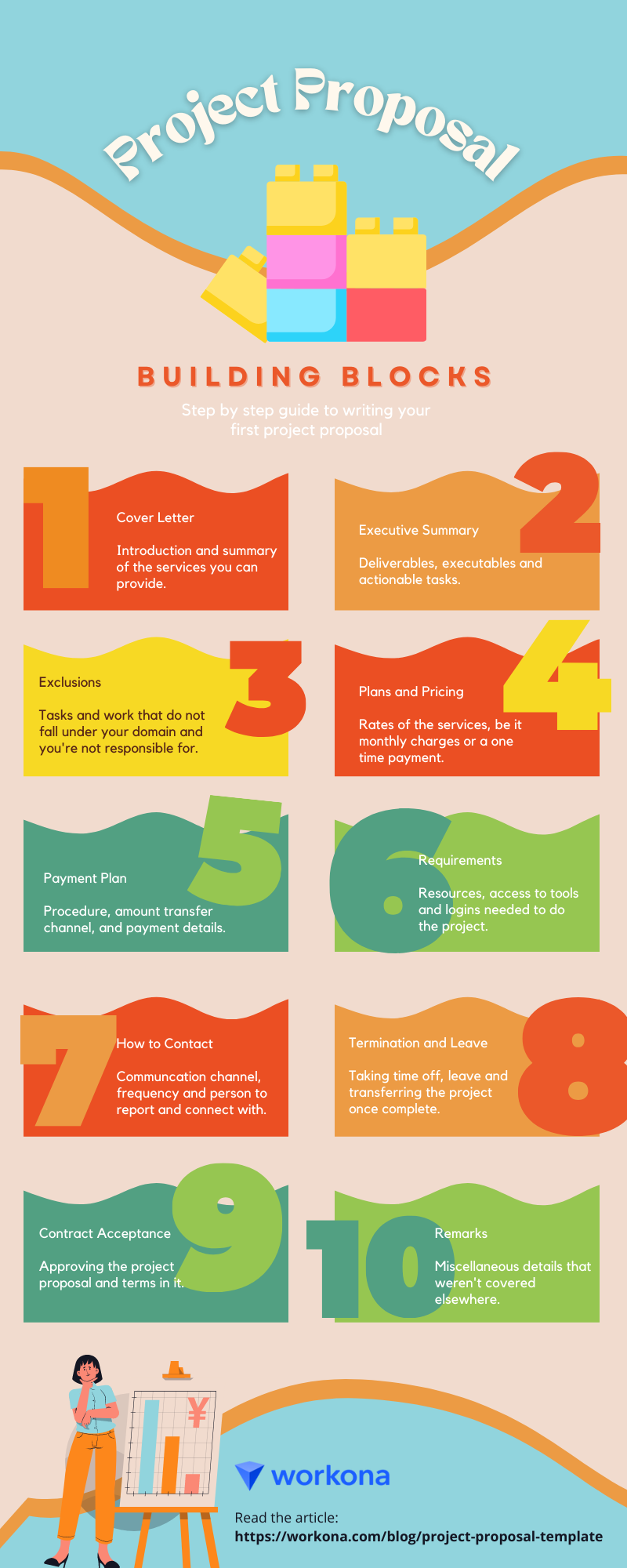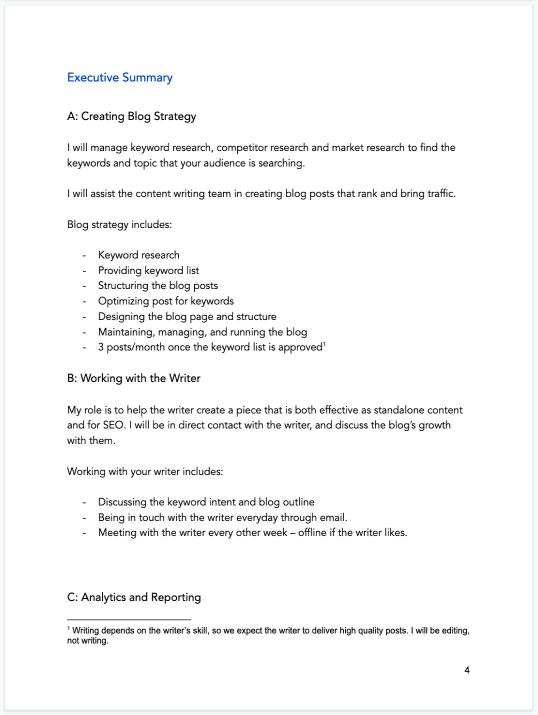
How To Write A Project Proposal for Freelancers (W/ Template)
Congratulations! You've been asked to send a project proposal.
The only problem is…you don’t know how to write one. Don’t worry; every freelancer has been stuck here at some point.
Project proposals are critical to helping prospective clients and freelancers decide if they should work together. But creating one from scratch can be overwhelming.
This quick project proposal guide will help you, a freelancer or junior person at an agency, create a proposal and ideally win the client’s business. You can check out the instructions below, or see the Google Docs template here →

Jump to:
- Why make a project proposal?
- How to conduct research for project proposals
- How to build a project proposal
- Personalizing the proposal for your client
- Grab your copy → Project Proposal Template for Content Marketing | Google Docs
What is a project proposal?
A project proposal is a document summarizing and outlining the project deliverables, outcomes, and deadline. The goal is for businesses and freelancers to come to an agreement regarding project idea and scope. A complete proposal includes:
- Project details & objectives
- Project timeline
- Project requirements
With a well-crafted proposal, you can not only get approval to move forward with the project, but also ensure the project will get the resources it needs to be successful.
Why make a project proposal?
You may be thinking, “Do I really need to send a proposal? Isn’t it simpler to discuss the details in person or over email?”. While it’s true that direct communication is fastest, project proposals are often required by potential clients. This is true even if you have a friendly existing relationship with the client.
Whether the clients have a request for proposal (RFP) or not, it’s worth creating one for other reasons:
1. Create a project blueprint
A glance at the proposal will let newcomers and third parties know what both parties should deliver. This can clear up misunderstandings over the project objective, tasks involved, expected outcomes, and pricing, among other details.
2. Build credibility
Stakeholders will calculate the ROI (return on investment) before giving the green light to any project. The project proposal gives these stakeholders more reasons to say yes to you over less-structured proposals.
3. Set expectations
With clear expectations and KPIs (key performance indicators) set forth in a project proposal, it’s easier for clients to measure your performance. Plus, your team will know the exact targets to keep the client happy.
4. Start negotiations
Project proposals act as a unified base to negotiate the pricing and deliverables. Don't be afraid to name your price early on, as this will weed out clients who aren't a good fit.
5. Function as a source of truth
Once approved, the project proposal functions as the source of truth, cutting down on unnecessary back-and-forth with your client.
How to conduct research for project proposals
Research is what separates a standout proposal from a sea of mediocre ones. Your research should focus on:
Service you provide: For example, if your agency provides reputation management services, you’ll analyze the brand’s digital presence including reputation, reach, reviews, complaints, social media, and positioning.
Who you're pitching: For example, if you’re sending a proposal to the CTO, you’ll focus on the technical scope and requirements of the project. On the other hand, a CEO might prefer KPIs and business outcomes.
As you present your research, think about it this way: You’re trying to prove that your business is the best fit for this project. Whatever data makes the most compelling case for that should get top billing.
You should also familiarize yourself with external factors that are important to your client, e.g.,
- Industry
- Content
- Product
- Audience
- Marketing
- Positioning
- Competitors
The closer you are to the brand, the more your proposal will line up with the client's goals.
How to build a project proposal
A project proposal is no small undertaking, so it’s best to start well in advance. Think weeks, if not months!
The building blocks of a proposal are:
- Cover Letter
- Executive Summary
- Exclusions
- Plans and Pricing
- Payment Plan
- Requirements
- How to Contact
- Termination
- Acceptance (Sign-Off)
- Remarks

1. Cover letter
A cover letter introduces yourself and summarizes the proposal. It provides an opportunity to showcase your success with similar projects.
A cover letter includes:
- Formal header
- Your introduction
- Purpose of the project
- Expected outcome of the project
- Testimonials, feedback, and reviews from past clients
- Closing statement and contact information
2. Executive summary
Executive summary is an opinionated piece that covers the project plan and deliverables you recommend. List all the services you’ll be providing for the project.
Some tips to keep in mind:
- Propose a solution based on what you know of the client’s problem, external factors, and your own expertise
- Be concise and to the point — your client may have dozens of proposals to get through
- Visualize the data for quick consumption
Most importantly, be clear about what you can and can't deliver. Parthi Loganathan, CEO at Letterdop, warns about customer dissatisfaction. A dissatisfied client will cost you more than just losing that client — it can deter future customers if anyone asks about you.
3. Exclusions
Some tasks are connected so closely that the business assumes you will manage them too. An exclusions section saves you from doing work that you're not supposed to do.
For example, an email marketing firm is typically not responsible for:
- Website speed
- Landing pages
- Transactional emails
4. Plans and pricing
You can structure your rates in one of two ways:
- Bundle pricing: Offer several similar services at one rate.
- Individual pricing: Each service comes at different rates; businesses can pick whichever service(s) they like.
The bundle pricing prevents a client from leaving important services on the table. For example, if you’re a full-service marketing firm, you may insist that customers opt for analytics as part of any package.
5. Payment Plan
To make the transaction smooth, spell out payment details:
- Any advance payment such as a retainer fee
- How to pay: Invoice address, acceptable methods of payment, etc.
- Due date for payment (remittance)
- Refund policy
- Action for missed payments
Payment plans ensure you get paid for the work, and also include an action plan if invoices are delayed or not paid.
6. Requirements
For any project, you’ll need access to client resources. For example, a freelance social media manager will need logins to the social media platforms. They may also need access to static resources like videos and logos, plus ongoing support such as internal updates that haven’t gone public yet.
For security reasons, you may have to make a case for each point of access requested.
Mariusz Michalowski, community manager at Spacelift, says the organization has to protect in-house and customer’s information. "We share the passwords on a need to know basis. Mentioning your requirements early is important as we might not be sharing the account’s ownership, and we need to know if it affects your tasks.”
7. How to contact
This section will help you stick to just one or two channels for client communication– preferably where the messages can be saved for indefinite time.
State the best time to contact you and the average time it takes to respond, so unexpected messages do not hinder productivity.
8. Termination and leave
Free time brings clarity, innovation, and creativity — all of which your clients will appreciate.
The section covers termination and leave policies so your clients are prepared for anything:
- How much time you may take off
- Duration of notice period before terminating or pausing your services
- Process of transferring the accounts and deliverables during notice period
- Procedure of refund and payment if either party wants to end the partnership early
9. Contract acceptance (sign off)
You made it to the end! This is where both parties sign and date the proposal if they’re ready to move forward.
10. Remarks
Miscellaneous details or legalese can be added under the Remarks section, e.g.,
- Security & privacy policies
- Terms & conditions
- Case study & testimonial permissions
- Organizational guidelines, such as anti-harassment policies
Tips for personalizing a project proposal draft
1. Sync with brand
Browse the business's website and check out its brand presence online. Identify the brand's core color scheme and language to use in the proposal.
Use the same industry terms as they do. For example, if the brand writes 'ecommerce' as 'Ecommerce', that’s the version you should use, too.
Add their logo to the front page, and copy their colors to the headings. People like the sound of their name, and brands like their own design.
2. Edit as needed
Your first proposal is not going to be perfect – but the aim is to make it functional and then edit based on the client's feedback. If the business wants to negotiate pricing or services, acknowledge it promptly so you don’t lose their business to a more responsive competitor.
We all want a “Hell yes!” from the potential client after sending a well-crafted proposal. But you won’t get there if the proposal does not reflect the value you can provide
Hopefully, this article has given you all the tips you need to write a compelling project proposal.
Once you understand the building blocks of a proposal, you can create one for any type of client.
Best of luck!
Project Proposal for Freelancers - Google Doc Template
If you want to get a jump start on your project proposal, just follow our project proposal template for content work in Google Docs.
How to use this project proposal template:
- Click this link
- Confirm that you want to make a copy
- Edit & rename the template as needed


About the author:
Faizan Fahim is a content manager at Breeze, creating ecommerce oriented content. He likes writing about B2B SaaS, content marketing, emails, and cloud computing. Faizan’s words have been featured in Semrush, Wordstream, Clutch, Goodfirms and more. You can connect with him on Twitter and his website.